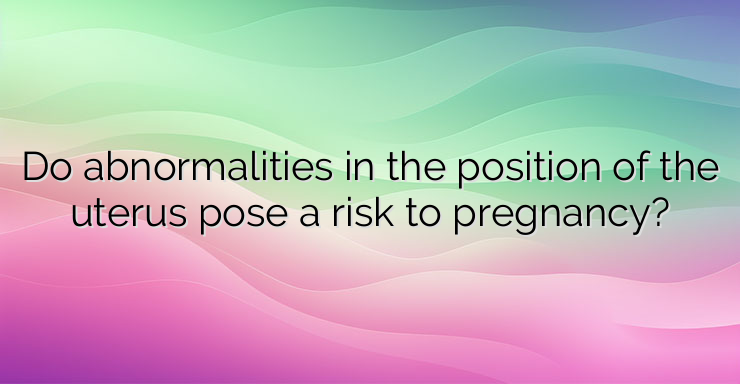The uterus is a partially mobile organ fixed in the lower part of the pelvis at the cervix. This anatomical relationship allows the fundus of the uterus to move relatively freely in the sagittal, vertical, oblique and anteroposterior planes. Hypermobility occurs during the non-pregnant state, but is more common during pregnancy and can sometimes lead to retroversion. Less commonly, inversion may occur after birth. Uterine torsion or prolapse during pregnancy is rare. All these conditions require timely diagnosis and treatment. Periodic contractions of the myometrium and changes in the position of the uterus are normal during pregnancy. Rarely, various obstetric complications result from uterine malposition (retroversion or incarceration), inversion, and, rarely, prolapse, torsion, or herniation. Retroversion from any cause becomes a problem of clinical significance if it progresses to uterine closure after pregnancy is established. Fixation of the uterus by adhesions is also a risk factor for the rare complication of uterine torsion. Uterine retroversion is a common and usually asymptomatic condition. One in five women experience uterine malrotation, either congenital or due to an acquired condition. In cases where pathology is present, conditions associated with retroversion include the following: Chronic salpingitis with pelvic adhesions; Endometriosis with adhesions; Tumors disturbing the shape or position of the uterus; Ovarian tumors; Leiomyomas; Pelvic congestion syndrome; Allen-Masters syndrome (Caused by traumatic rupture of the ligamentous apparatus of the uterus, mainly the fascial tissue of the broad uterine ligaments). Symptoms associated with uterine retroversion include: Pelvic discomfort, pressure, or pain; Menstrual disorders; Dyspareunia; Infertility, miscarriage; Constipation; Difficult urination, retention of urine; Pelvic congestion syndrome; Allen-Masters syndrome. If symptoms occur only from retroversion in non-pregnant women, they are minimal. Pelvic pain and other symptoms associated with malrotation are mainly due to incidental pathology. Evidence that retroversion alone is responsible for abortions or infertility is weak. In these conditions, another etiology should be sought. During pregnancy, retroversion of the uterus is a normal variant of the position of the uterus. Typically 10-20% of pregnant women experience retroversion temporarily in early pregnancy. However, if the malrotation persists into the middle of the first trimester, it predisposes to uterine entrapment and closure. While retroversion is common, symptomatic retention is not. The condition occurs in approximately 1 in 3,000 pregnancies. Malrotation progresses to closure with urinary retention or other acute symptoms in only approximately 2% of women with this condition. References: 1. Awad JT, Azar GB, Karam KS:Puerperal uterine inversion. J Med Libanais 2. Bakos O, Axelsson O: Pathologic torsion of the pregnant uterus. Acta Obstet Gynecol Scand 3. Barr SJ, Barr KJ: Retroversion and infertility. Am J Obstet Gynecol 4. Brown FJ: Uterine inversion. Proc R Soc Med London


Leave a Reply